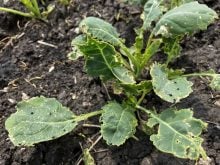WOODSTOCK, Ont. — The Austrian Haytec system is based on the premise that quality hay preserves protein and sugars better than silage and stretches the milking life of a cow by two years.
Haytec factory rep Klaus Wannenmacher was at Canada’s Outdoor Farm Show in September to introduce his company’s innovative haying system to Canadian farmers.
“In silage you lose 15 percent to 20 percent of the protein because of fermentation. In bad silage, protein loss goes up to 35 or 40 percent. Also, you lose sugar in the fermentation process,” he said.
Read Also

Growing garlic by the thousands in Manitoba
Grower holds a planting party day every fall as a crowd gathers to help put 28,000 plants, and sometimes more, into theground
“We make good hay that is barn dried. We bring it in at 30 percent to 35 percent moisture. We dry it two days to four days so it is more than 90 percent dry matter. That’s how we save as much as 95 percent of the protein. And the sugar is totally in the hay. If the weather is wet and the drying process takes too long, then occasionally we can get mouldy and dusty hay. But that isn’t often.
“If you feed only hay like some dairy farms in Europe, the health of the animal is better and the average age of the herd will go up two years or more. You have cows that are seven or eight years old that are still milking really well. Also, omega 3 and omega 6 is higher in hay milk compared to silage milk.”

















